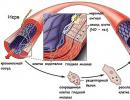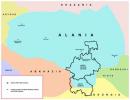Speed of sound in water. Chapter IX Acoustic properties of sea water How the speed of sound is measured
Sound is one of the components of our life, and people hear it everywhere. To consider this phenomenon in more detail, we first need to understand the concept itself. To do this, you need to turn to the encyclopedia, where it is written that “sound is elastic waves propagating in some elastic medium and creating mechanical vibrations in it.” In simpler terms, these are audible vibrations in any environment. The main characteristics of the sound depend on what it is. First of all, the speed of propagation, for example, in water differs from other environments.
Any sound analogue has certain properties (physical characteristics) and qualities (reflection of these characteristics in human sensations). For example, duration-duration, frequency-pitch, composition-timbre, and so on.
The speed of sound in water is much higher than, say, in air. Consequently, it spreads faster and is heard much further. This happens due to the high molecular density of the aquatic environment. It is 800 times denser than air and steel. It follows that the propagation of sound largely depends on the medium. Let's look at specific numbers. Thus, the speed of sound in water is 1430 m/s, in air - 331.5 m/s.
Low-frequency sound, for example, the noise produced by a running ship's engine, is always heard somewhat earlier than the ship appears in the visual range. Its speed depends on several things. If the temperature of the water increases, then, naturally, the speed of sound in the water increases. The same thing happens with an increase in water salinity and pressure, which increases with increasing water depth. Such a phenomenon as thermoclines can have a special role on speed. These are places where layers of water of different temperatures occur.
Also in such places it is different (due to the difference in temperature). And when sound waves pass through such layers of different densities, they lose most of their strength. When a sound wave hits a thermocline, it is partially, or sometimes completely, reflected (the degree of reflection depends on the angle at which the sound falls), after which a shadow zone forms on the other side of this place. If we consider an example when a sound source is located in a body of water above the thermocline, then below it it will be not only difficult, but almost impossible to hear anything at all.
Which are emitted above the surface, are never heard in the water itself. And the opposite happens when under the water layer: above it it does not sound. A striking example of this is modern divers. Their hearing is greatly reduced due to the fact that water affects them, and the high speed of sound in water reduces the quality of determining the direction from which it is moving. This dulls the stereophonic ability to perceive sound.
Under the layer of water, it enters the human ear most of all through the bones of the skull of the head, and not, as in the atmosphere, through the eardrums. The result of this process is its perception by both ears simultaneously. At this time, the human brain is not able to distinguish between the places where the signals come from and in what intensity. The result is the emergence of consciousness that the sound seems to roll in from all sides at the same time, although this is far from the case.
In addition to what is described above, sound waves in water have such qualities as absorption, divergence and dispersion. The first is when the strength of sound in salt water gradually fades away due to friction of the aquatic environment and the salts in it. Divergence is manifested in the distance of sound from its source. It seems to dissolve in space like light, and as a result its intensity drops significantly. And the oscillations disappear completely due to dispersion by all sorts of obstacles and inhomogeneities of the environment.
Speed of sound
If mechanical vibrations of its particles (compression and rarefaction) are excited in sea water, then, due to the interaction between them, these vibrations will begin to propagate in the water from particle to particle at a certain speed With. The process of propagation of vibrations in space is called wave. The particles of the liquid in which the wave propagates are not transported by the wave; they only oscillate around their equilibrium positions. Depending on the direction of particle oscillations relative to the direction of wave propagation, they are distinguished longitudinal And transverse waves. In water, only longitudinal waves can occur, i.e., those waves in which particle vibrations occur along the direction of wave propagation. Longitudinal waves are associated with volumetric deformation of an elastic medium. The formation of transverse waves (particles oscillating in a direction transverse to propagation) does not occur in water due to the fact that they arise only in a medium that can resist shear deformation. Water does not have this property.
Sound waves weak disturbances propagating in water are called oscillations with small amplitudes.
The process of propagation of sound waves (sound speed), due to the high frequency of oscillations, it is adiabatic, i.e., not accompanied by heat exchange. In this regard, sea water, from an acoustic point of view, is similar to an ideal gas. Unlike air, sea water weakly absorbs the energy of sound vibrations. In addition, the speed of sound in water is practically independent of the vibration frequency, i.e., there is no wave dispersion.
As is known from physics, the speed of sound propagation in a continuous elastic medium is determined by the formula:
where K = - = p 0 -(f/f)| - adiabatic volumetric module
elasticity, po - density of the undisturbed medium, k„ - coefficient of adiabatic compressibility. Due to the fact that both the bulk modulus of elasticity K and the density of undisturbed sea water rho depend on its salinity, temperature and hydrostatic pressure, the speed of sound is also determined by these state parameters (Fig. 5.4).


Rice. 5.4. Dependence of the speed of sound of sea water (m s 1) on salinity and temperature at atmospheric pressure (a), pressure and temperature at S = 35 psu (b). US-80 was used in the calculations
Pressure, dbar
Let us transform formula (5.10) so that it includes quantities convenient for calculations. To do this, we rewrite the derivative included in (5.10) as follows:

Comparing this expression with (5.7), we get:

where v is the specific volume, k is the coefficient of isothermal liquefaction
affordability, y =- - ratio of specific heat capacities at -
constant pressure and volume, respectively.
Equation (5.11), if we use the equation of state US -80, can be modified:

where Г is the adiabatic temperature gradient.
Formula (5.12) is used to calculate the speed of sound and is called theoretical. It was used to compile the famous Matthews sound speed tables, as well as O.I. Mamaev and some others.
Along with the theoretical formula (5.12), there are empirical formulas for determining the speed of sound, based on modern laboratory methods for measuring it. The most reliable of them can be considered the formulas of V. Wilson, V. Del Grosso and K. Chen-F. Millero.
According to the calculated values of the speed of sound, the latter is closest to the theoretical ones using the US-80. It looks like:

40 ps (PShS-78), temperature - from 0 to 40 ° C (MShPT-68) and pressure - from 0 to 1000 bar. Pressure R enters (5.14) in bars.
Changes in seawater temperature make the greatest contribution to changes in the speed of sound propagation. As it increases, the elastic modulus K increases and the density po decreases, which leads, according to (5.10), to an increase in the speed of sound. At the same time, the change in speed with a temperature change of 1°C decreases at high temperatures compared to low ones.
Salinity has less effect on the speed of sound. It has been noted that salts contained in sea water have different effects on the bulk modulus of elasticity, i.e., K, and, consequently, on the speed of sound. With increasing salinity, as well as with increasing temperature, the speed of sound increases. The speed of sound also increases with increasing pressure.

Rice. 5.5.
For oceans where water temperature decreases with depth, the speed of sound decreases. However, starting from a certain depth, the increase in hydrostatic pressure outweighs the role of water temperature and the speed of sound begins to increase. Thus, at a certain horizon a layer with minimal sound speeds is formed - underwater sound channel(Fig. 5.5). In it, thanks to refraction, sound rays sent horizontally are concentrated in a layer of minimum speed and propagate over very long distances (up to 15,000-18,000 km).
The average speed of sound in the World Ocean is approximately 1500 m/s. The distribution of sound speed in the ocean is described in more detail in the work.
Tasks and questions for review
- 5.1. What is the bulk modulus of elasticity?
- 5.2. Why is adiabatic compressibility less than isothermal?
- 5.3. How does the isothermal compressibility coefficient depend on the salinity, temperature and pressure of seawater?
- 5.4. Find how the internal energy changes during adiabatic compression?
Answer:
Let's apply the Jacobian method - formulas 2.59, 2.60, 2.61, 2.63, 2.67, 2.69, 2.70, 2.71 and 2.72. We have:

All parameters are positive, therefore - > 0, i.e. when
dr 1 h
adiabatic compression, the internal energy increases. This is explained by the fact that at constant entropy (there is no heat exchange with the environment), with increasing external pressure, the average distance between molecules decreases, their average kinetic energy increases, and, consequently, the temperature increases.
- 5.5. What waves are called sound waves?
- 5.6. What affects the speed of sound in sea water?
- 5.7. Due to this, an underwater sound channel is formed in the ocean.
Sound travels 4.5 times faster in seawater than in air. The speed of its spread depends on temperature, salinity and pressure. As any of these factors increases, the speed of sound increases.
How is the speed of sound measured?
It can be calculated by knowing temperature, salinity and depth - the three main characteristics measured at oceanographic stations. For many years this method was the only one. In recent years, the speed of sound in seawater has been measured directly. Sound speed meters work on the principle of measuring the length of time during which a sound pulse travels a certain distance.
How far can sound travel in the ocean?
The sound vibrations generated by the underwater explosion of the Columbia University research vessel Vema in 1960 were recorded at a distance of 12,000 miles. A depth charge was detonated in an underwater sound channel off the coast of Australia, and after about 144 minutes the sound vibrations reached Bermuda, that is, almost the opposite point on the globe.
What is an audio channel?
This is a zone in which the speed of sound first decreases with depth to a certain minimum, and then increases due to increasing pressure. Sound waves excited in this zone cannot leave it, since they bend and return to the axis of the channel. Once in such a channel, sound can travel thousands of miles.
What is SOFAR?
This is an abbreviation of the English words “sound fixing and ranging” (detecting sound sources and measuring the distance to them). The SOFAR system uses a sound channel at depths of 600 - 1200 m. Using observations from several receiving stations, you can determine the location of the sound source in this channel with an accuracy of 1 mile. During World War II, this system was used to save many pilots shot down over the sea. Their planes had small bombs that exploded under pressure when they reached the depth of the sound channel.
What is sonar?
Sonar works on the same principle as radar, only it uses sound (acoustic) waves instead of radio waves. Sonar can be active or passive. An active system emits sound vibrations and receives a reflected signal, or echo. To determine the distance, you need to take half the product of the speed of sound and the time elapsed between the emission of the sound pulse and the reception of the reflected signal. A passive system operates in listening mode, and with its help you can only determine the direction in which the sound source is located. Sonar is used to detect submarines, navigate, search for schools of fish and to determine depth. In the latter case, the sonar is a conventional echo sounder.
What is refraction and reflection of sound waves?
Due to differences in the density of seawater, sound waves in the ocean do not travel straight. Their direction is bent due to changes in the speed of sound in water. This phenomenon is called refraction. In addition, sound energy is scattered by suspended matter and marine organisms, reflected from and scattered at the surface and bottom, and finally attenuated as it propagates through the water column.
What causes the sound of the sea?
Sea noise includes the noise of waves and surf, noise caused by precipitation, seismic and volcanic activity, and, finally, sounds made by fish and other marine organisms. Noises caused by the movement of a vessel, the operation of mechanisms extracting minerals, as well as noise created during underwater and surface oceanographic work, arising outside the platforms and measuring equipment themselves, are also considered sea noise.
Waves, tides, currents
Why do waves occur?
Those waves; which we are accustomed to seeing on the surface of the water are formed mainly under the influence of wind. However, waves can also be caused by other reasons: underwater earthquakes or underwater volcanic eruptions. Tides are also waves.
Over long distances, sound energy travels only along gentle rays that do not touch the ocean floor along the entire path. In this case, the limitation imposed by the environment on the range of sound propagation is its absorption in sea water. The main mechanism of absorption is associated with relaxation processes accompanying the disturbance by an acoustic wave of the thermodynamic equilibrium between the ions and molecules of salts dissolved in water. It should be noted that the main role in absorption in a wide range of sound frequencies belongs to the magnesium sulfur salt MgSO4, although in percentage terms its content in sea water is very small - almost 10 times less than, for example, NaCl rock salt, which nevertheless does not play a role any significant role in sound absorption.
Absorption in sea water, generally speaking, is greater the higher the sound frequency. At frequencies from 3-5 to at least 100 kHz, where the above mechanism dominates, absorption is proportional to frequency to the power of about 3/2. At lower frequencies, a new absorption mechanism is activated (possibly due to the presence of boron salts in water), which becomes especially noticeable in the range of hundreds of hertz; here the level of absorption is anomalously high and falls significantly more slowly with decreasing frequency.
To more clearly imagine the quantitative characteristics of absorption in sea water, we note that due to this effect, sound with a frequency of 100 Hz is attenuated 10 times over a path of 10 thousand km, and with a frequency of 10 kHz - at a distance of only 10 km (Figure 2). Thus, only low-frequency sound waves can be used for long-distance underwater communication, long-range detection of underwater obstacles, etc.
Figure 2 - Distances at which sounds of different frequencies attenuate 10 times when propagating in sea water.
In the region of audible sounds for the frequency range 20-2000 Hz, the propagation range of medium-intensity sounds under water reaches 15-20 km, and in the ultrasound region - 3-5 km.
Based on the sound attenuation values observed in laboratory conditions in small volumes of water, one would expect significantly greater ranges. However, under natural conditions, in addition to attenuation caused by the properties of water itself (the so-called viscous attenuation), its scattering and absorption by various inhomogeneities of the medium also affect it.
Refraction of sound, or curvature of the path of a sound beam, is caused by heterogeneity in the properties of water, mainly vertically, due to three main reasons: changes in hydrostatic pressure with depth, changes in salinity and changes in temperature due to unequal heating of the water mass by the sun's rays. As a result of the combined effect of these reasons, the speed of sound propagation, which is about 1450 m/sec for fresh water and about 1500 m/sec for sea water, changes with depth, and the law of change depends on the time of year, time of day, depth of the reservoir and a number of other reasons. . Sound rays emerging from the source at a certain angle to the horizon are bent, and the direction of the bend depends on the distribution of sound speeds in the medium. In summer, when the upper layers are warmer than the lower ones, the rays bend downwards and are mostly reflected from the bottom, losing a significant share of their energy. On the contrary, in winter, when the lower layers of water maintain their temperature, while the upper layers cool, the rays bend upward and undergo multiple reflections from the surface of the water, during which much less energy is lost. Therefore, in winter the range of sound propagation is greater than in summer. Due to refraction, so-called dead zones, i.e. areas located close to the source in which there is no audibility.
The presence of refraction, however, can lead to an increase in the range of sound propagation - the phenomenon of ultra-long-range propagation of sounds under water. At some depth below the surface of the water there is a layer in which sound travels at the lowest speed; Above this depth, the speed of sound increases due to an increase in temperature, and below this depth, due to an increase in hydrostatic pressure with depth. This layer is a kind of underwater sound channel. A beam that has deviated from the axis of the channel up or down, due to refraction, always tends to fall back into it. If you place the source and receiver of sound in this layer, then even sounds of medium intensity (for example, explosions of small charges of 1-2 kg) can be recorded at distances of hundreds and thousands of km. A significant increase in the range of sound propagation in the presence of an underwater sound channel can be observed when the sound source and receiver are located not necessarily near the channel axis, but, for example, near the surface. In this case, the rays, refracting downward, enter deep-sea layers, where they are deflected upward and exit again to the surface at a distance of several tens of kilometers from the source. Next, the pattern of ray propagation is repeated and as a result a sequence of so-called rays is formed. secondary illuminated zones, which are usually traced to distances of several hundred km.
The propagation of high-frequency sounds, in particular ultrasounds, when the wavelengths are very small, is influenced by small inhomogeneities usually found in natural bodies of water: microorganisms, gas bubbles, etc. These inhomogeneities act in two ways: they absorb and scatter the energy of sound waves. As a result, as the frequency of sound vibrations increases, the range of their propagation decreases. This effect is especially noticeable in the surface layer of water, where there are most inhomogeneities. The scattering of sound by inhomogeneities, as well as uneven surfaces of water and the bottom, causes the phenomenon of underwater reverberation, which accompanies the sending of a sound impulse: sound waves, reflecting from a set of inhomogeneities and merging, give rise to a prolongation of the sound impulse, which continues after its end, similar to the reverberation observed in enclosed spaces. Underwater reverberation is a fairly significant interference for a number of practical applications of hydroacoustics, in particular for sonar.
The range of propagation of underwater sounds is also limited by the so-called. the sea's own noises, which have a dual origin. Some of the noise comes from the impact of waves on the surface of the water, from the sea surf, from the noise of rolling pebbles, etc. The other part is related to marine fauna; This includes sounds made by fish and other marine animals.
Sea water is an acoustically inhomogeneous medium. The heterogeneity of sea water consists of changes in density with depth, the presence of gas bubbles, suspended particles and plankton in the water. Therefore the spread acoustic vibrations (sound) in sea water is a complex phenomenon that depends on the density distribution (temperature, salinity, pressure), sea depth, the nature of the soil, the state of the sea surface, the turbidity of the water with suspended impurities of organic and inorganic origin and the presence of dissolved gases.
Sound in a broad sense is the oscillatory movement of particles of an elastic medium, propagating in the form of waves in gaseous, liquid or solid media; in a narrow sense, a phenomenon subjectively perceived by a special sense organ of humans and animals. A person hears sound with a frequency from 16 Hz to 16-20×10 3 Hz . The physical concept of sound covers both audible and inaudible sounds. Sound with a frequency below 16 Hz called infrasound , above 20 ×10 3 Hz - ultrasound ; the highest frequency acoustic vibrations in the range from 10 9 to 10 12 -10 13 Hz refer to hypersound.
The propagation of sound in water represents periodic compression and rarefaction of water in the direction of movement of the sound wave. The speed of transmission of oscillatory motion from one water particle to another called the speed of sound.
The theoretical formula for the speed of sound for liquids and gases is: c = , where α is the specific volume, γ =  - the ratio of the heat capacity of water at constant pressure c p to the heat capacity of water at constant volume c v, approximately equal to unity, k is the true compressibility coefficient of sea water.
- the ratio of the heat capacity of water at constant pressure c p to the heat capacity of water at constant volume c v, approximately equal to unity, k is the true compressibility coefficient of sea water.
With increasing water temperature, the speed of sound increases both due to an increase in specific volume and due to a decrease in the compressibility coefficient. Therefore, the influence of temperature on the speed of sound is greatest compared to other factors. When the salinity of water changes, the specific volume and compressibility coefficient also change. But corrections to the speed of sound from these changes have different signs. Therefore, the effect of changes in salinity on the speed of sound is less than the effect of temperature. Hydrostatic pressure affects only the vertical change in the speed of sound; the speed of sound increases with depth.
The speed of sound does not depend on the strength of the sound source.
Using a theoretical formula, tables have been compiled that make it possible to determine the speed of sound based on the temperature and salinity of water and correct it for pressure. However, the theoretical formula gives values of the speed of sound that differ from the measured ones on average by ±4 m·s -1. Therefore, in practice, empirical formulas are used, of which the most widespread are the formulas Del Grosso and W. Wilson, ensuring the least errors.
The error in the speed of sound, calculated using the Del Grosso formula, does not exceed 0.5 m·s -1 for waters with a salinity of more than 15‰ and 0.8 m·s -1 for waters with a salinity of less than 15‰.
Wilson's formula, proposed by him in 1960, gives higher accuracy than Del Grosso's formula. It is built on the principle of constructing the Bjerknes formula for calculating the conditional specific volume in situ and has the form:
c = 1449.14 + δс p + δс t + δс s + δс stp ,
where δс p is the correction for pressure, δс t is the correction for temperature, δс s is the correction for salinity and δс stp is the total correction for pressure, temperature and salinity.
The root-mean-square error in calculating the speed of sound using Wilson's formula is 0.3 m·s -1.
In 1971, another formula was proposed for calculating the speed of sound from the measured values of T, S and P and slightly different correction values:
c = 1449.30 + δс p + δс t + δс s + δс stp ,
When measuring depths with an echo sounder, the speed of sound averaged over layers is calculated, which is called the vertical speed of sound. It is determined by the formula with stp  ,
,
where c i is the average speed of sound in a layer of thickness h i .
The speed of sound in sea water at a temperature of 13 0 C, a pressure of 1 atm and a salinity of 35‰ is equal to 1494 m s -1; as already indicated, it increases with increasing temperature (3 m s -1 per 1 0 C), salinity (1.3 m s -1 per 1 ‰) and pressure (0.016 m s -1 per 1 m depth) . It is approximately 4.5 times the speed of sound in the atmosphere (334 m s -1). The average speed of sound in the World Ocean is about 1500 m s -1 , and the range of its variability is from 1430 to 1540 m s -1 on the ocean surface and from 1570 to 1580 m s -1 at depths of more than 7 km.






